The sculpture in question is the Sagan Planet Walk, a scale model of the solar system on a 5,000,000,000:1 scale. The sun is represented as a window in a large black monolith:
It's about six feet tall (I'm afraid the photos are just what I happen to have, I have no time today to go get new ones, and I didn't think to get a photo of someone standing next to it.) It's in the middle of the Ithaca Commons, a pedestrian-only walkway at the center of downtown Ithaca. The next for monoliths (which are each a bit smaller) are all on the same block. In fact, in the background of the photo above, you can see the Earth and Mars megaliths:
(The Venus monolith is directly behind the Sun monolith in this shot; Mercury is off to the left, beyond the edge of the photo.)
Each of the planets is represented by a slightly smaller grey monolith (except Pluto (yes, this was back before Pluto's demotion) which has a monolith matching that of the Sun, to anchor the other end of the Planet Walk). Here, for example, is the one for Mercury:
And here's the one for Jupiter:
The window in the center of each Monolith is identical in size to the window which represents the sun, in order to give a sense of scale. The actual planet is represented by a to-scale size model of the planet embedded in the window. In most cases, you can only see it by going right up to the window and looking very closely; it's often hard to tell the planet from a speck of dirt (although the planet is in the center of each window, and of course you can tell if you look closely enough.) But the larger planets you can see even from a few feet away. For example, here is an enlargement of the Jupiter window above:
And here is an enlargement for the Saturn window:
For Jupiter, they also include several moons (the four big ones, I think) and the Saturn window includes Triton; but you can't see them with the level of detail in these pictures. Incidentally, in those two pictures, Jupiter looks smaller than Saturn, but that's a result of the framing and angle of the photos; in the actual monument, Jupiter is quite clearly bigger than Saturn (aside from the latter's rings, which even things out a bit.)
On the front of each monolith is a plaque giving information about the planet. There's also a podcast by Bill Nye which you can listen to as you do the walk (although I've never heard it -- it's fairly new -- even though I've done the walk more than a dozen times from end to end, not counting passing it just strolling around town (we live near Uranus, so I go by parts of the walk all the time.))
What's really cool about the memorial, however -- it's purpose, really -- is not possible to capture in photos, and that's the visceral sense of the sheer size of the space, and of the extraordinary emptiness of it. It takes about half an hour to walk from the Sun (at the heart of downtown) to Pluto, right in front of the Sciencenter, the local science museum. But walking it you imagine almost all of it as empty, save for these tiny little specks of nothing captured in the windows. Even the sun seems tiny. It's dizzying: our universe is basically extended void, a vast amount of nothing, with just a few insignificant specks of fire and dust. It is, in a powerful sense which gets lost in the common use of the phrase, awe-inspiring.
And of course the distances vary greatly. It's a matter of moments to walk from the Sun to Mars; each of the other distances gets progressively longer, save for the Neptune - Pluto distance which is shorter (although still long on the Sun - Mars scale). Here is the official map from the Sciencenter web site:
You can get a slight sense of the distances from this map -- but not as well as you can from an ordinary astronomy textbook. What really works is the sculpture itself: putting the entirety on a human scale, so you can feel it, get the variations under your shoes and in your legs.
It is a marvelous memorial for the late, lamented Carl Sagan, who spent his life trying to educate the public about astronomy and science: a beautiful piece of public art that also serves to convey, on a marrow-in-the-bones level, the feeling of awe that our universe can inspire when looked at through science's lens.
But my favorite thing about the planet walk I don't have a photograph of. It isn't on the map; it isn't in Ithaca -- it doesn't even exist yet, and it probably never will. But there has been talk apparently about building a matching, to-scale monolith for Alpha Centauri, the nearest star to the Sun.
It would be in Hawaii.
I love to imagine that it will be built: making the Sagan Planet Walk one of the largest public sculptures in the world (since, after all, the space between the monoliths is an integral part of the sculpture), and boggling the mind with the true vastness and emptiness of this extraordinary cosmos that we live in.
In any event, next time you are in Ithaca (which, to be sure, is in the middle of nowhere -- it's not even directly on a major interstate -- so it may be a while for most of you) take the time to walk the planet walk. It's a wonderful bit of public art, and worth taking the time to appreciate properly. And a wonderful tribute to an amazing man.
In Memoriam
Carl Sagan
1934 - 1996
Carl Sagan
1934 - 1996
Update: Joel Schlosberg has now put up a post linking to the various entries of the blog memorial. Go there to check 'em out.
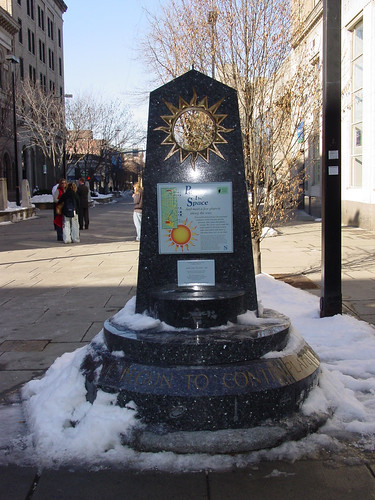
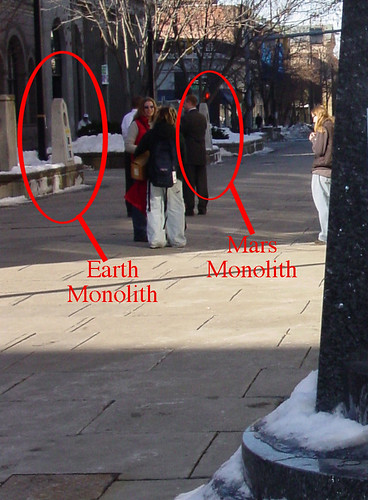
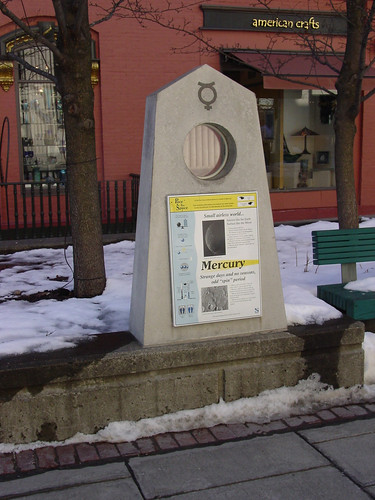
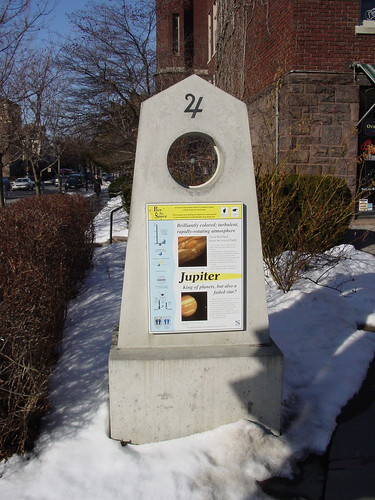

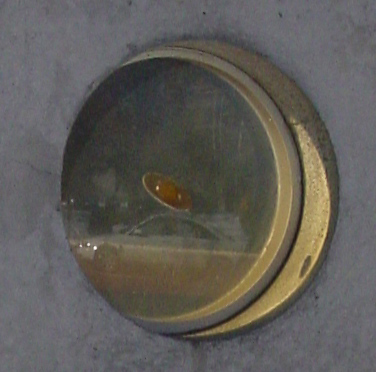
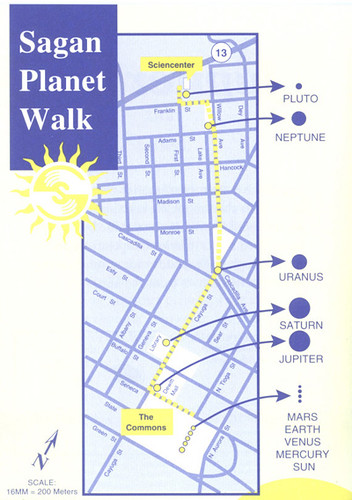
6 comments:
http://www.zwire.com/site/news.cfm?newsid=18167546&BRD=1395&PAG=461&dept_id=546876&rfi=6
A Organizational Voyage
By Larry Klaes
Cornell University professor and world-renowned astronomer and scientist Carl Sagan unquestionably is one of Ithaca's most well-known former residents, having lived in this town from his arrival to teach at the university in 1968 until his death from myelodysplasia in late 1996.
As a scientist and educator, Sagan brought the wonders of the universe to millions of people through his writings and other works for decades. He also worked tirelessly with his wife, Ann Druyan, the CEO of Cosmos Studios, to support, promote, and debate the most pressing social issues of his time, many of which are still with us today.
When Patrick Fish was in the eighth grade, he watched Sagan's landmark Cosmos television series on PBS when it premiered in 1980. Fish found Sagan to be an "island of sanity" in his world.
Fish's sense of wonder and admiration for Sagan only grew during the years, even as his life took him in several different directions. Last January, Fish learned about the blog-a-thon that took place across the Internet, honoring Sagan on Dec. 20, the 10th anniversary of his death. The online celebration inspired the Utica resident to become familiar with his boyhood hero again.
"I read a lot about and by Carl that was online," said Fish. "I became reacquainted with Sagan and his ideas, such as his studies of the greenhouse effect that makes the planet Venus so hot and its relationship to our understanding of global warming on Earth. I also admired how Sagan used his research into the concept of nuclear winter to play a role in pressuring the United States and Soviet Union to give up on the idea that a thermonuclear attack could be winnable for either side during the Cold War. Sagan was a scientist who did not lose his humane ethic."
A recent visit to Sagan's resting place at Lakeview Cemetery, where Fish was struck by the "humbleness" of the late astronomer's grave marker and several articles about the man resting at the site, led him to begin solidifying the idea of a permanent tribute to Sagan in his longtime residence.
"At first I thought getting this idea rolling would be difficult," explained Fish. "However, I found only goodwill towards Sagan and his memory in Ithaca."
Fish's initial plan involves the upcoming Ithaca Festival Parade on May 31. He plans to have a car-float in the parade that reflects on some of the major themes and events of Sagan's life.
"My plan is to have a model of the twin Voyager space probes that explored the outer Solar System in the 1970s and 1980s. I would like to have the hubcaps on each of my car's tires covered with a replica of the golden Interstellar Record placed aboard each Voyager probe," said Fish. The golden records contain images, messages, and music from humanity to anyone who finds those robot craft drifting through space in the distant future.
Other items for the Sagan parade float include a rendition of the plaque placed aboard two other earlier space probes named Pioneer 10 and 11 and a model of the Cosmos 1 solar sail craft, which did not achieve Earth orbit when its launch rocket failed in 2005.
Fish also hopes to use his parade float for the promotion and growth of the Sagan Appreciation Society (SAS), which he describes as "an ad hoc group of science-minded folk, skeptics, humanists, environmentalists, peaceniks, Sagan fanboys and girls, etc."
"The participation in the parade will be the first public act of the SAS," stated Fish. "The warm reaction to the idea of a Sagan parade-float lead to expanding the concept beyond just a parade entry and into a Sagan Gathering that will overlap and hopefully cross-pollinate with the Ithaca Festival. Up until this point, we've had no media exposure and no outreach campaign yet, and already we have commitments from as far away as Indiana. But what we need are more Ithaca-area people to get involved in the planning process."
Fish is also looking for people who knew Carl Sagan who would like to talk and share their stories about Sagan, perhaps as part of a series of panel discussions. "Men like Sagan motivate people. Those who knew him can really energize the public to deal with issues Sagan brought up that still go on today." Fish, who would ultimately like to see a Carl Sagan statue standing in Ithaca Commons, mirrored one of his mentor's concerns that have only compounded with time.
"Our culture has become more reliant on science and technology than ever before, but we are understanding it less and less, such as genetically modified foods. Carl Sagan and Ann Druyan brought an artful way for a passionate expression of science. They were definitely in love with science, which not everyone appreciates or understands, but it is critical to the survival of our species and every other species on Earth."
To participate in the Sagan Appreciation Society and the Ithaca Festival parade float, contact Patrick Fish at this e-mail address:
SaganGathering@yahoo.com.
The Sagan Planet Walk: Ten Years Later
By Larry Klaes
Tompkins Weekly - November 5, 2007
Taking a stroll between the Ithaca Commons and the most direct route to the Sciencenter, one is likely to encounter ten angular monuments along their way. At its most basic level, these slabs of rock are representations of the major worlds of our Solar System, accurately scaled down to 3/4th of a mile in diameter. But the Sagan Planet Walk, as it is known, is much more than just a model: The monuments are both a tribute to a local legend and an integral part of the community they quietly illuminate about our celestial neighborhood every day.
It was ten years ago, on November 8, 1997, that the Sagan Planet Walk was dedicated on the day before the birthday of the man it is named after, Cornell astronomer and science popularizer Carl Sagan. Less than one year earlier, Sagan had passed away from a rare form of leukemia called myelodysplasia that he had been battling for over two years.
Hundreds of people attended the dedication ceremony in the Ithaca Commons on that cold autumn morning. The speakers included state and local politicians, staff members of the Sciencenter who played key roles in making the Sagan Planet Walk a reality, Sagan’s widow Ann Druyan, Louis Friedman, the Director of The Planetary Society which he co-founded with Sagan in 1980, and Bill Nye “the Science Guy”, for whom Sagan was a mentor at Cornell. A tour of that relatively miniature Solar System was given to the crowd afterwards by students from the Cornell Department of Astronomy all the way to distant Pluto on the grounds of the Sciencenter.
While Sagan was in one sense just one of many scientists and professors who work and live in Ithaca, he was also an academic who truly loved the subjects he researched and taught. Sagan also loved sharing his knowledge of the literal Universe with the wider populace, who he felt were often unaware of the wonders of the world around them as displayed through science, but were equally as eager to learn. This desire to share these wonders led Sagan to produce numerous books on science and one science fiction novel, Contact, which became a film of the same name in 1997. Sagan’s 1980 PBS television series, Cosmos, assured his name and face recognition well beyond Ithaca. Sagan even shared his love and knowledge with the Universe: He spearheaded several space projects that conveyed information about our species and our planet into the Milky Way galaxy for any possible intelligent beings dwelling among the stars.
As for Ithaca itself, along with his university duties spanning back to 1968, Sagan was a member of the Sciencenter Advisory Board, where he utilized his talents to make science both comprehensible and fun for the community. All this led to members and staff of the Sciencenter and many residents to suggest and promote the Planet Walk as a tribute and memorial to Sagan. When Ann Druyan offered her encouragement to dedicate the monuments to her late husband and sponsored the Sun monument, the Sciencenter forged ahead to make sure that everything was in place to dedicate the Planet Walk on what would have been Sagan’s 63rd birthday.
The origin of the Sagan Planet Walk goes back to the spring of 1995, where at a meeting of the Sciencenter Exhibits Committee the idea of an outdoor model of the Solar System was first proposed. Among those who proposed the concept were Charlie Trautmann, executive director of the Sciencenter, and Robert Orrange, chairman of the Exhibits Committee.
“It was quickly determined that a model scaled at 1 part in 5 billion would fit between the Ithaca Commons and the Sciencenter, a distance of ¾ mile,” said Orrange, who also became the project manager for the Sagan Planet Walk. “At this scale, the Sun would be 11 inches in diameter, the gas giants Jupiter and Saturn about 1 inch in diameter, and Earth about 1/10 inch in diameter.”
By the fall of 1995, local artist Erin Caruth and geologist Bill Bassett had come onboard the project to plan a conceptual design of the Planet Walk. Cornell astronomers Yervant Terzian and Jim Bell served as scientific advisors.
“With encouragement from responsible city organizations and others, we were able to agree on locations and proceed to develop a design which was aesthetically appealing and sensitive to its surroundings,” explains Orrange.
Orrange says the objective of the exhibit is to encourage self-guided tours by the public and school groups “to acquire a real sense of the magnitude of the Solar System and the size of the planets, which cannot be achieved in the classroom.”
In the ten years that the Sagan Planet Walk has become a fixture in Ithaca, the monuments have not only survived the elements but the continual accumulation of new astronomical knowledge as well. A few things have changed in the decade since the monuments were conceived and dedicated, such as the number of known moons for the Jovian worlds: As of 2007, Jupiter has 63 natural satellites, Saturn has 60, Uranus has 27, and Neptune has 13.
Last year, a group of professional astronomers decided that Pluto was no longer one of the major planets but instead was just the most famous member of the vast number of Kuiper Belt Objects that dwell in the dark and cold recesses of our outer Solar System. Otherwise, the facts and images emblazoned on each monument remain as solid as the granite and concrete they are attached to.
To learn more about the Sagan Planet Walk, including how to purchase a Passport to the Solar System and download a free podcast tour of the planets narrated by Bill Nye, check out this page on the Sciencenter Web site:
http://www.sciencenter.org/saganpw/
Proposed Carl Sagan commemorative stamps unveiled
at Ithaca Sciencenter
By Anne Ju
A movement to immortalize famed Cornell astronomer
Carl Sagan with a U.S. postage stamp was launched
Feb. 11 for local media at the Ithaca Sciencenter.
Patrick Fish, founder of the Utica-based grassroots Sagan
Appreciation Society, and Charles Trautmann, executive
director of the Sciencenter, unveiled four renderings by
three artists or artist teams of proposed Sagan memorial
stamps that the society plans to submit to the U.S. Postal
Service for commissioning.
"As Carl was America's science popularizer, it seems fitting
that he be bestowed with a populist kind of honor," Fish said.
"Carl wasn't just an astronomer, physicist and the world's
pre-eminent science teacher. He was arguably the first
exobiologist, one of the fathers of global-warming awareness,
a peacemaker and a brilliant author who could make science
sound like poetry."
Trautmann read a statement by Sagan's widow, author Ann
Druyan, at the media launch. She described how Sagan had
been an avid stamp collector as a boy and how that interest
was perhaps early evidence of his "passion for the diversity
of Earth's cultures."
Full article here:
http://www.news.cornell.edu/stories/Feb08/sagan.stamps.aj.html
Alpha Centauri = nearest *star
(system)*, not planet.
I'm assuming they would treat Alpha Cen as a three star system including Proxima Centauri.
Thanks, Jean-Louis. Typo fixed. (I'm rather embarrassed it's been up there all that time!)
You may not remember, but we've met at Readercon several times. So I hope to see you there again! In the meantime, thanks for stopping by -- I hope you come back from time to time.
We have huge bronze statues of college football players, mountains named after “somewhat sketchy” park rangers and no really significant memorial anywhere for Carl. Sad.
Post a Comment